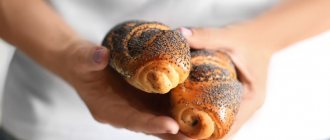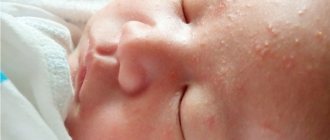Abnormalities in stool
Parents constantly monitor the condition of the baby's stool. By its color and consistency, you can promptly identify problems with the functioning of the digestive system, as well as draw a conclusion about the presence of some abnormalities. White or black spots may appear in your baby's stool.
White lumps in baby's stool
Stool with white spots in a child is not uncommon. They usually resemble cheesy lumps.
On a note. There is a big difference between white inclusions and veins. The appearance of the latter is an alarming signal. You need to see a doctor urgently.
If white spots appear during breastfeeding, this indicates a high fat content of mother's milk.
The appearance of cheesy white lumps indicates overeating
With artificial feeding, white spots may indicate a change in diet (this is a change in formula, the appearance of new foods in complementary foods). This condition indicates that the changed diet is not completely absorbed by the child. Only after the inclusions have disappeared can new products be introduced.
Most often, white lumps in stool indicate banal overeating. In this case, the white impurities resemble a curdled mass.
If white grains appear in your child’s stool, as well as certain accompanying symptoms, you should consult a doctor:
- Lactose intolerance. Additionally, there are frequent bowel movements (more than 10 times). Feces are liquid and foamy. Medical consultation is required. If the diagnosis is confirmed, then the regular mixture is replaced with a lactose-free one. When breastfeeding, lactase enzymes are added to each serving of milk.
- Dysbacteriosis. Large white inclusions resemble lumps in shape. There is green mucus in the stool, and the stool has an unpleasant odor. Consistency and color are constantly changing. After the examination, the pediatrician will prescribe a comprehensive treatment to restore the intestinal microflora.
- Helminthic infestations. This is a rare occurrence for infants. The most common lesion is pinworms; they are the ones that curl into balls and are visible in the feces in this form. Sanitation will be required, as well as treatment with special medications for all family members.
- Infectious inflammation. Grains, white mucus and lumps in the stool are accompanied by severe pain in the tummy. There may be a fever, the baby may cry, or there may be weight loss. Immediate medical attention is required.
If the baby’s general condition worsens and spots appear in the stool, be sure to consult a doctor.
To avoid such problems, parents should constantly monitor the condition and behavior of the baby.
It is important to maintain personal hygiene and sanitary standards. The baby's body is very susceptible to viruses and diseases
Black balls in baby's stool
Black spots can appear in a baby's stool for various reasons. In rare cases, they indicate serious violations. Most often, this is a sign of an infant’s digestive system that is unresponsive to new foods or the result of taking medications:
- Excess iron, which enters the child's body as part of a mixture or vitamin complexes and is not absorbed, can be excreted during stool. Most often these are small black inclusions in the form of balls.
- New food products. Not all foods are digested by the fragile stomach of a little man. For example, seeds, berries and fruits may be partially excreted undigested.
- In some cases, the appearance of blackheads may indicate a disease. Then the change in the color of the stool will be accompanied by other symptoms: a change in the child’s behavior, increased body temperature, vomiting, nausea, and abdominal pain.
On a note. Black strings, balls, dots never mean the presence of worms. Parasites with this color simply do not exist.
The cause of a child's stool turning black, as well as the appearance of dark spots in it, can be due to the use of medications, these are:
- antibiotics;
- ibuprofen;
- Activated carbon;
- bismuth-based preparations;
- paracetamol.
After some time after taking the medication, the color of the stool should be restored.
Possible diseases
Intestinal diseases constitute a fairly large group of diseases of the gastrointestinal tract and are almost always characterized by changes in the color, consistency and appearance of feces. Pathologies in which one of the clinical signs may be the appearance of white spots or a white film in the stool are listed below.
Enterobiasis
White spots in the stool may be the eggs of pinworms - nematodes that parasitize the intestinal lumen after entering the gastrointestinal tract. Enterobiasis is characterized by intense anal itching, burning, and redness of the skin around the anus. The stool may retain its usual consistency, but white lumps may be found on its surface, which are helminth eggs.
It is not always possible to detect signs of pathology visually, so adults are recommended to be examined for enterobiasis at least once a year.
Crohn's disease
A severe systemic disease manifested by inflammation of all parts of the digestive tract, including the esophageal tube and oral cavity. It may have various symptoms, including various pains in the epigastric and abdominal areas, vomiting, and lack of appetite (against this background, patients experience significant weight loss). Almost 65% of patients experience fecal incontinence, and the excrement itself looks like a poorly formed mush with various streaks and inclusions.
Treatment of the pathology is surgical, followed by supportive drug therapy. The risk of mortality during an exacerbation is about 35%. Patients with Crohn's disease receive lifelong disability after surgical treatment.
The appearance of any impurities in the stool is an alarming symptom, even if the person feels normal and does not have any complaints. Some intestinal pathologies may remain asymptomatic for a long time, so any changes in the appearance of stool should be a reason to consult a doctor.
Green stool in a newborn
Why a baby has green stools cannot be answered with certainty. Unnaturally green stools against the background of increased gas formation and a body rash can signal disturbances in the intestinal microflora and dysbacteriosis. Green, foamy stool in infants is often associated with lactose intolerance. Stools containing staphylococci and streptococci will also be green and foamy. When an infection occurs, the baby usually vomits, has a fever, and suffers from intestinal colic, and the first aid in this case will be an urgent medical examination. Medicinal mixtures and iron supplements also give the stool a greenish tint.
About treatment
Each case of a problem is treated based on the diagnosis, and only a pediatrician can diagnose it for newborns. The doctor will prescribe a dysbacteriosis test for the baby; depending on the results, additional studies may be required.
If all the indicators are normal, then it is necessary to review the mother’s menu or the mixture used, change them and watch the dynamics; bowel movements will return to normal very quickly. Other problems will be treated in accordance with the focus:
- Intestinal infections are treated with tablets or solutions depending on the type of infection, and a diet is also prescribed.
- For diarrhea, Smecta is prescribed; the solution has an antibacterial effect.
- If lactose deficiency is detected, the doctor prescribes drugs such as Lactase Baby or Lactazar, they contain an enzyme that helps lactose to be absorbed.
- After identifying dysbiosis, the specialist will prescribe prebiotics, most often this is the drug Bifiform Baby.
- Cause of runny nose or acute respiratory infection: expectorant medications may be prescribed. Remember that when you have a runny nose, snot can be removed using an aspirator.
- If the mucus appears as a result of taking antibiotics, the doctor will also prescribe prebiotics to restore the intestinal microflora.
As you can see, most often the presence of mucus in the stool without other symptoms is not dangerous. However, never self-medicate, because we are talking about children's health. Consult your local pediatrician, then all your doubts will be dispelled.
How long should a newborn poop?
New mothers always have a lot of questions regarding the health of the child. One of the most common: How many times a day should a newborn poop? This question worries young mothers for good reason, because the child’s stool indicates how his digestive system works, and whether the baby has enough nutrition.
It would be wrong to compare your child with the child of a friend or neighbors. All children are individual: what is normal for one may be a cause for concern for another. Yes, even the same baby can recover 10 times in a day, or may not poop for several days.
In many ways, the frequency of stool in newborns depends on the type of feeding. Typically, breastfed babies have fewer intestinal disorders and their stool frequency ranges from 1 to 7 times a day. Children on artificial or mixed feeding usually go to the toilet less often - up to 4 times a day.
It is important to focus on the child’s general well-being: is he calm, is his tummy soft, is his appetite good?
It is also necessary to pay attention to the consistency of the stool. Mushy or liquid is considered normal, but solid is a signal of indigestion.
The disease may be indicated by mucus, lumps and, especially, bloody streaks. This is a reason to contact your pediatrician.
If your newborn doesn't poop much, don't worry. Even for a breastfed baby, one stool per day is normal. But if the baby strains excessively and cries when defecating, then the child is constipated. To solve the problem, you need to use laxative products (a few drops of flaxseed decoction, vegetable oil, beet juice). In extreme cases, use an enema. Its dimensions should be minimal - up to 30 ml. The temperature of the filler water is slightly warmer than room temperature.
A tummy massage (move your hand clockwise) is a great help for constipation. Also, from time to time, the baby needs to be placed on his stomach, as the baby tenses his muscles, which has a beneficial effect on intestinal function.
Frequent stool
As noted earlier, newborns poop constantly, so frequent bowel movements should not be a cause for concern. If your newborn poops frequently, you should be concerned if there are impurities, it foams, has a greenish color or a sharply unpleasant odor. Especially if there is an increase in body temperature. It is likely that the baby has caught an intestinal infection or is lactose intolerant. In this case, you cannot do without consulting a specialist! He will recommend the most effective remedy.
Be more attentive to your child, and you will soon easily learn to recognize when he is experiencing discomfort.
Discolored stool
Hepatitis
46471 August 25
IMPORTANT!
The information in this section cannot be used for self-diagnosis and self-treatment.
In case of pain or other exacerbation of the disease, diagnostic tests should be prescribed only by the attending physician. To make a diagnosis and properly prescribe treatment, you should contact your doctor. The color of stool depends on the amount of bile pigments (products of the breakdown of hemoglobin), coloring substances contained in food and medications, admixtures of fresh or clotted blood, and metabolic products of microorganisms living in the intestines.
In the absence of strongly coloring food pigments, the color of stool is normally light to dark brown.
Stercobilin, a breakdown product of bilirubin, gives stool its brown color. A change in the color of stool from light green to yellowish-gray can occur with various diseases.
If bilirubin does not enter the gastrointestinal tract for any reason, the stool will become discolored. Such feces are called acholic. Discolored stool can have a different consistency, which is determined by the amount of water consumed, plant fiber, intestinal tone and other factors. These factors are taken into account when diagnosing liver diseases.
Possible reasons
Damage to the hepatic and bile ducts
.
If the patency of the hepatic ducts is impaired cholestasis
, which is characterized by acholic feces. Cholestasis can be caused by blockage of the ducts with small stones (cholelithiasis), blood clots, parasites (with opisthorchiasis, fascioliasis, clonorchiasis), and can also be a consequence of congenital anomalies, cicatricial stenosis, and the presence of tumors of the bile ducts. The lumen of the common bile duct may be narrowed due to tumor growth, due to inflammation and cysts of the pancreas, recurrent cholangitis, lymphadenitis due to tuberculosis, sarcoidosis, or be a consequence of surgical treatment and adhesions. In all cases, the flow of bile from the liver is impaired.
Symptoms of cholestasis are: skin itching, jaundice, discoloration of stool and dark urine; severe cases are manifested by a flu-like condition (chills and fever).
Sclerosing cholangitis
is a pathology that is also accompanied by discoloration of stool due to a violation of the outflow of bile. With this disease, sclerosis of the bile ducts occurs (replacement of healthy organ tissue with scar connective fibers) due to inflammatory processes.
Sclerosing cholangitis in most cases is accompanied by inflammatory diseases of the gastrointestinal tract (ulcerative colitis, Crohn's disease).
Patients develop jaundice of the skin, mucous membranes and sclera, itching, weakness and fatigue, weight loss, impaired motor activity due to limited mobility of the limbs (symptoms of osteoporosis).
Functional disorders of the biliary tract
. Functional dysmotility of the biliary tract - biliary dyskinesia - is one of the most common causes of changes in the color of stool. This is due to a narrowing (muscle spasm) of the lumen of the bile ducts and duodenal papilla, which regulates the flow of bile into the intestine.
Spasm can occur due to hormonal disorders, systemic diseases, pain, or after surgical interventions. In this case, the stool discoloration will not be permanent. The stool becomes light only after spastic attacks, and during the period of resumption of motility of the biliary tract, its color returns to normal.
Considering that the brown tint of stool is caused by bile pigments, any process of disruption of their synthesis or entry into the gastrointestinal tract is accompanied by a change in the color of the stool. Discolored feces do not always indicate illness: with excessive consumption of fatty foods
the usual amount of bile is not enough to process all the absorbed fats, and the feces become light in color.
In some infectious diseases
(cholera, salmonellosis, dysentery),
digestive disorders
(inadequate absorption of nutrients, irritable bowel syndrome), increased intestinal motility leads to the rapid movement of feces, which do not have time to change color.
If discolored feces persistently form, diseases of the hepatobiliary system (liver, gallbladder, hepatic and bile ducts, sphincter of Oddi) should be suspected.
Degenerative-inflammatory liver diseases (hepatitis of various etiologies, cirrhosis) affect the synthesis and metabolism of bile pigments and bilirubin, which is often manifested by uncolored feces.
Damage to liver cells (hepatocytes)
. Hepatocytes that produce bile can die under the influence of many factors.
The infectious nature of liver diseases should be considered first.
hepatitis
viruses enter the blood, an acute infectious disease develops, which is manifested by high fever, nausea, vomiting, heaviness and pain in the right hypochondrium, a yellow coloration of the sclera appears (icterus), urine darkens, and feces become discolored.
When infected with hepatitis B and C viruses,
the process often becomes chronic. The incubation period for hepatitis C can be up to six months, and in the acute period of the disease, symptoms resemble a respiratory infection. Chronic viral hepatitis B and C, if left untreated, can lead to cirrhosis and liver cancer. Hepatitis can be accompanied by cytomegalovirus infection, diseases of herpes viral etiology, infectious mononucleosis (caused by the Epstein-Barr virus).
Currently, alcoholic hepatitis
.
Ethyl alcohol products and its metabolites have a direct damaging effect on liver cells.
The chronic course of alcoholic liver disease ends with massive replacement of hepatocytes by connective tissue with complete loss of their functions. In the clinical picture, the main complaints are heaviness and characteristic pain in the right hypochondrium, which can radiate to the arm, shoulder blade, and lumbar region. Yellowness of the skin develops, the sclera develops, feces become discolored, urine darkens, and signs of encephalopathy appear. In the last stages of alcoholic illness, cirrhosis of the liver, liver failure, bleeding from varicose veins of the esophagus, etc. develop.
Among the toxins that have a destructive effect on liver cells
, include plant poisons (some mushrooms, bittersweet and groundsel juice) and industrial chemicals (phosphorus, arsenic, organochlorines, phenols, pesticides). Many drugs (anti-inflammatory, antiviral, antituberculosis, anticonvulsants) change the functional activity of hepatocytes, which affects the color of stool.
Liver cells die due to oxygen starvation caused by circulatory failure and oxygen deficiency in the blood. With hepatic cell failure syndrome, a dysfunction of hepatocytes occurs, which is accompanied by general intoxication of the body.
Diagnostics and examination
For complaints of discolored, acholic stools, diagnosis includes physical and laboratory tests.
Information about the functioning of the liver and gallbladder is provided by general blood and urine tests; biochemical blood test (aspartate aminotransferase, alanine aminotransferase, alkaline phosphatase, bilirubin, glucose, amylase and lipase).
Baby's stool is normal
The color and characteristics of newborn stool vary. The appearance of stool depends on the age of the child, as well as the type of diet.
When breastfeeding
When feeding only breast milk, the newborn stools almost after every feeding - 6-7 times a day. It has a mushy consistency. The norm is yellow color without impurities and mucus.
Yellow stool is normal for a breastfeeding baby.
As the baby grows, the number of bowel movements decreases. Complementary foods are gradually introduced into the child's diet. The stool becomes thicker and turns brown. The shade may vary depending on the type of food and products used.
If your baby's stool becomes greenish during breastfeeding, looks like diarrhea, and foams a little, then you should reconsider your feeding technique. This condition indicates that the baby mainly eats only superficial breast milk, which has few nutrients. The baby should be placed on the same breast again so that he can suck out more useful hind milk. When receiving only foremilk, the stool takes on a greenish tint.
Artificially fed
A bottle-fed baby's stool is different - it is thicker and darker. The color of your baby's poop depends on the type of formula. Dark yellow or dark orange stools are considered normal.
On a note. Bright yellow or bright orange may indicate liver problems. It is necessary to consult a pediatrician for advice.
As complementary foods are introduced, the color of the stool changes. White spots may appear, which indicate that not all food is digested.
The color of stool will change as your baby grows
Before introducing additional foods into the diet, the child’s stool resembles a thick paste of uniform consistency. If the stool is too thin or, conversely, thick, you need to reconsider your diet. Most of all, dense stool causes discomfort to the child.
The smell during artificial feeding is much stronger than when the baby is fed mother's milk. The introduction of complementary foods enhances it even more. The danger is the pronounced smell of rot.
A child whose diet is based on formula empties his ventricle up to 6 times a day. As the newborn's body develops, the frequency of stool decreases. This is due to the fact that formula, unlike mother’s milk, takes longer to be absorbed and processed by the small body.
Where do white spots in stool come from and what could it be?
White specks in stool are not always a sign of a problem with your body or the presence of a disease. In order to more accurately determine the origin of foreign bodies, it is necessary to observe the feces for some time.
White spots in stool are of the following types:
- In the form of lumps or grains;
- In the form of threads, veins or worms.
They can also be divided into two groups based on origin:
- Food products, in this case, white grains are harmless and are not a cause for concern;
- Parasites;
- Disturbance of microflora and inflammatory processes in the intestines.
Below we will take a closer look at all types of white inclusions and find out what they can be.
Yellow stool with mucus
A sign of teething or a cold can often be yellow stool in a newborn with mucus.
If such discharge is constantly in the baby's diaper, this may indicate problems with the stomach.
Not sure what causes mucus in your baby's stool? Here are some of the common reasons:
- This is normal stomach function.
Mucus is secreted by the intestines to aid in bowel movements. In breastfed babies, most of the stool will be mucous, as milk is well digested.
- Infections.
Sometimes bacteria such as salmonella or E. coli affect the functioning of a child's esophagus.
This results in the presence of blood or large amounts of mucus in the baby's stool. The child may also suffer from diarrhea, vomiting, and fever.
- Food allergies.
A newborn may have food allergies to foods eaten by the mother.
A baby's digestive system is not mature, so you may find that your baby cannot tolerate dairy products or spicy foods.
Other symptoms of food allergies include excessive gas and regurgitation.
You can determine the cause by avoiding certain foods for a period of time and checking your child's reaction.
For more information about a proper diet when breastfeeding, see the online course Nutrition for a nursing mother without harm to the baby>>>
- Teething.
When a baby goes through the teething phase, they tend to drool excessively, which can lead to intestinal irritation and, as a result, green mucus.
- Disease.
The child may catch a viral infection or stomach flu. This usually results in diarrhea in the form of foamy green stool.
Important! Continue to breastfeed your baby because breast milk contains antibodies that can help boost immunity. If this continues for more than a few days, consult a pediatrician to prevent dehydration
If this continues for more than a few days, consult a pediatrician to prevent dehydration.
Why do babies have white lumps in their stool?
White lumps that resemble cottage cheese in appearance are often observed in a baby's stool. This indicates incomplete digestion of milk or formula in the body. The reason for this phenomenon is the infant’s not fully formed digestive system. Therefore, the presence of white lumps in stool in the first months of life may be normal. Also, such lumps can be observed with high fat content of mother's milk. In some cases, the appearance of lumps, indicating incomplete digestion of food, becomes one of the symptoms of disorders of the digestive system. In formula-fed babies, white lumps in the stool may be signs of an incorrectly selected formula, overfeeding the child, or improper dilution of the formula.
However, white lumps in stool are not always so harmless; in some cases they are symptoms of various diseases. If, in addition to this sign, the child experiences slow weight gain, stagnation, or even loss, this may indicate a lack of digestive enzymes and reduced activity.
A similar symptom manifests itself as lactose intolerance, dysbiosis, intestinal infections and other pathologies. All of them require medical attention, so if you find white lumps in your stool, you should consult your pediatrician.
Lumps in the stool of a breastfeeding baby
Often, women who have recently given birth put their baby to the breast as often as possible, with every cry and squeak, this can lead to increased production of breast milk. The baby’s body is not yet fully formed and is not able to cope with so much incoming food, so it does not have time to be completely digested and absorbed. This results in white lumps in the stool. Also, such lumps may appear when complementary foods are introduced. In such cases, you should reduce the amount of the administered product or temporarily abandon its administration.
In any case, if you find white lumps in a baby’s stool, you need to carefully monitor the baby: does he have colic, is he gaining weight, is he sleeping well. When visiting a pediatrician, you should inform him about the impurities and undergo the necessary tests.
White lumps in the stool of a bottle-fed baby
In artificial infants, white lumps appear in the stool much more often. The stool itself in such babies has a thicker consistency, dark color and an unpleasant odor. Depending on the type of mixture, its composition and quality, white lumps may disappear or appear in the stool. The constant presence of such an impurity may indicate that the selected type of formula is not suitable for this baby. In addition, formula-fed babies are more likely to overeat than those fed breast milk.
A change in the consistency and color of stool, as well as the appearance of impurities in it, including white lumps, may be associated with a change in the baby’s diet: the introduction of complementary foods, a change in formula, or a switch from breast milk to formula. To avoid such a reaction, each new product or mixture change should be carried out slowly, gradually, adding 10-15 g of the new product per day and reducing the old one by the same amount. After the complete disappearance of the white lumps, we can talk about adaptation to a new mixture or complementary foods.
There are also pathological causes of white streaks or lumps in the stool. One of them is infection with roundworms or pinworms, which inexperienced parents can mistake for impurities in feces.
White lumps during artificial feeding
In children who are bottle-fed, stool has a slightly different consistency, darker in color and thicker. Therefore, parents whose children are fed artificial formula may often observe white lumps in their infant’s stool, and this is quite normal. It all depends on the type of mixture, its quality and the ratio of fats, proteins and carbohydrates in it.
Parents whose children are fed artificial formula may often observe white lumps in their infant's stool, and this is quite normal.
Very often, white cheesy lumps in a baby’s stool may indicate that the baby’s stomach is simply not able to process this particular type of mixture. But today there is a huge selection of artificial nutrition. Therefore, buying a suitable mixture will not be difficult. And in order to approach this issue more responsibly and seriously, you can consult a pediatrician who will help you choose the right nutrition for your baby.










